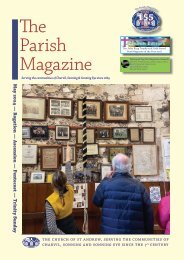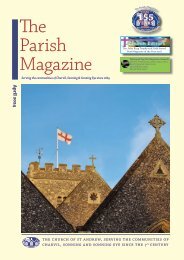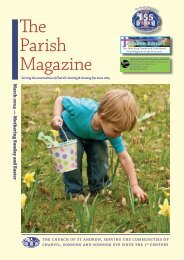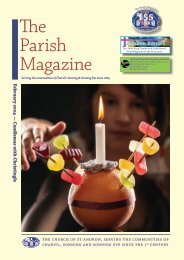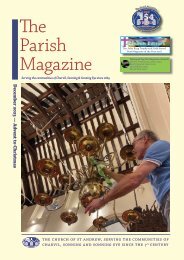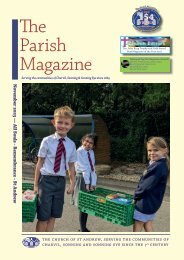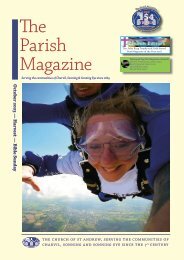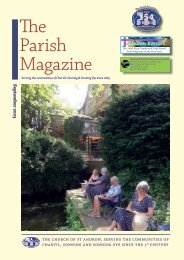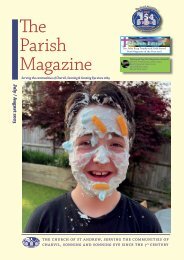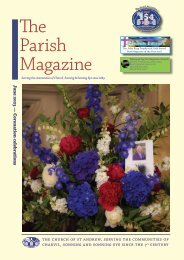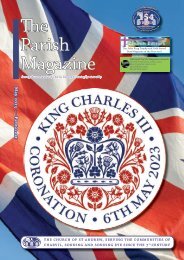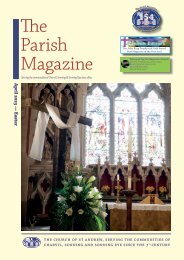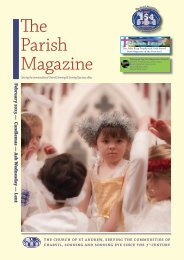The Parish Magazine November 2020
Serving the communities of Charvil, Sonning and Sonning Eye since 1869
Serving the communities of Charvil, Sonning and Sonning Eye since 1869
You also want an ePaper? Increase the reach of your titles
YUMPU automatically turns print PDFs into web optimized ePapers that Google loves.
the parish noticeboard — 2
Wartime social reformer
who was the first and last
While Winston Churchill led the country's war effort during
the Second World War, William Temple, as Archbishop of
Canterbury, encouraged the people to trust the Lord for
their deliverance and strength. Like Churchill, Temple was
a great leader, a gifted orator and a prolific writer. He was
also a social activist who helped to shape our society today.
The Church remembers him every year on 6 November.
William Temple was born on 15 October 1881 in Exeter and
was educated at Rugby School and Balliol College, Oxford,
from 1900-1904. He loved the music of Bach; the poetry of
Browning and Shelley, and Shakespeare, and was an avid
reader with a near-photographic memory.
He became president of the Oxford Union and after
graduating became a lecturer of philosophy at Queen's
College, Oxford. As a member of the debating society he had
shown that he proved to be a skilled and balanced debater.
NATIONAL FIGURE
After his ordination in 1909, Temple was headmaster of
Repton School for four years during which time he married
Frances Anson in 1916. They were childless.
1921 saw him becoming Bishop of Manchester where he
pioneered the Ecumenical Movement. Gradually he became a
national figure and in 1926 he urged the British government
to seek a negotiated agreement to the General Strike.
Excelling as a moderator, teacher and preacher, his
appointment in 1929 as Archbishop of York was a popular
one. His influence led to the formation of the British Council
of Churches and the World Council of Churches. During
the Second World War he jointly founded the Council of
Christians and Jews to combat anti-Semitism and other
forms of prejudice in Britain.
In 1942 he became Archbishop of Canterbury and was an
outspoken advocate of social reform and campaigned against
unemployment, poverty and poor housing. He believed in the
rights of all people, whether rich or poor, and was a leading
force for social justice. In his book Christianity and Social
Order he shared his vision for all to have access to healthcare,
education and decent housing. His radical thinking and
activism played a foundational role in the formation of the
British Welfare State.
When he died on 26 October 1944, he was the first
Primate of All England to be cremated— his ashes are buried
in the cloister garden of Canterbury Cathedral and he is the
last Archbishop of Canterbury to have died in office.
https://smile.amazon.co.uk/ch/1130763-0
When shopping online with Amazon you can help raise
funds for St Andrew's Church by logging in to Amazon
using the link above. AmazonSmile is the same Amazon
you know — except Amazon will donate 0.5% of the net
purchase price (excluding VAT, returns and shipping
fees) of eligible purchases to the
Parochial Church Council
of the Ecclesiastical Parish of Sonning.
The Parish Magazine - November 2020 9
From the desk
of the editor
editor@theparishmagazine.co.uk
Walking around Charvil
When the first national lockdown finished — as I write
this it seems that a second one is possible — my wife,
who was shielded, and I, began taking daily walks around
the parish. When on holiday overseas we take lots of long
walks but never seem to have time to do it regularly when
at home. Our short daily walks soon grew longer and
to-date our longest one took us from Charvil to Dinton
Pastures where, by the way, the cafe serves delicious hot
sausage rolls!
DOWN BY THE RIVER . . .
One Sunday after church we walked along the tow path
by the lock on the River Thames and quickly realised it
was not a good time to be there!
Not only was it crowded with families and dogs
enjoying the sunshine, which was good to see, but there
was a constant stream of runners and cyclists, often
travelling at speed and weaving their way through the
pedestrians.
Several times cyclists came from behind with no
warning. It was one of the most dangerous walks we have
been on, so now we concentrate on the footpaths around
Charvil where we can enjoy more peaceful and safer
surroundings.
This is not because we don't like meeting people, one of
the things we also enjoy when walking around Charvil is
that we often meet people we have not seen for a long time
and enjoy having a friendly catch up!
. . . AND ROUND THE LAKES
Despite having lived in or near Charvil for many years,
we were both surprised by the excellent facilities and
varied wildlife and plants that we did not realise were on
our doorstep in places such as the Charvil Country Park,
the Loddon Nature Reserve, Ashenbury Park and around
the many local fishing lakes.
Ashenbury Park can be accessed easily from Beggars
Hill Lane in Charvil. Originally it was the site of the
Woodley gravel pit and when I lived in Woodley about 40
years ago, it was the local council rubbish tip.
Talking of rubbish, we have been very impressed
on our walks by how well local residents care for the
surroundings. Often we come across individuals and
families clearing the woodlands or picking up litter, so a
special thank you to all those who volunteer to do this,
your efforts are greatly appreciated!
It would make life much better for everyone, of course,
if we all take our litter home or dispose of it safely.
Dumping rubbish, especially around the bottle bank or
public litter bins, is not only anti-social, environmentally
unfriendly and dangerous, but illegal.
NOVEMBER 2020.indd 9 11/10/2020 23:49:33




